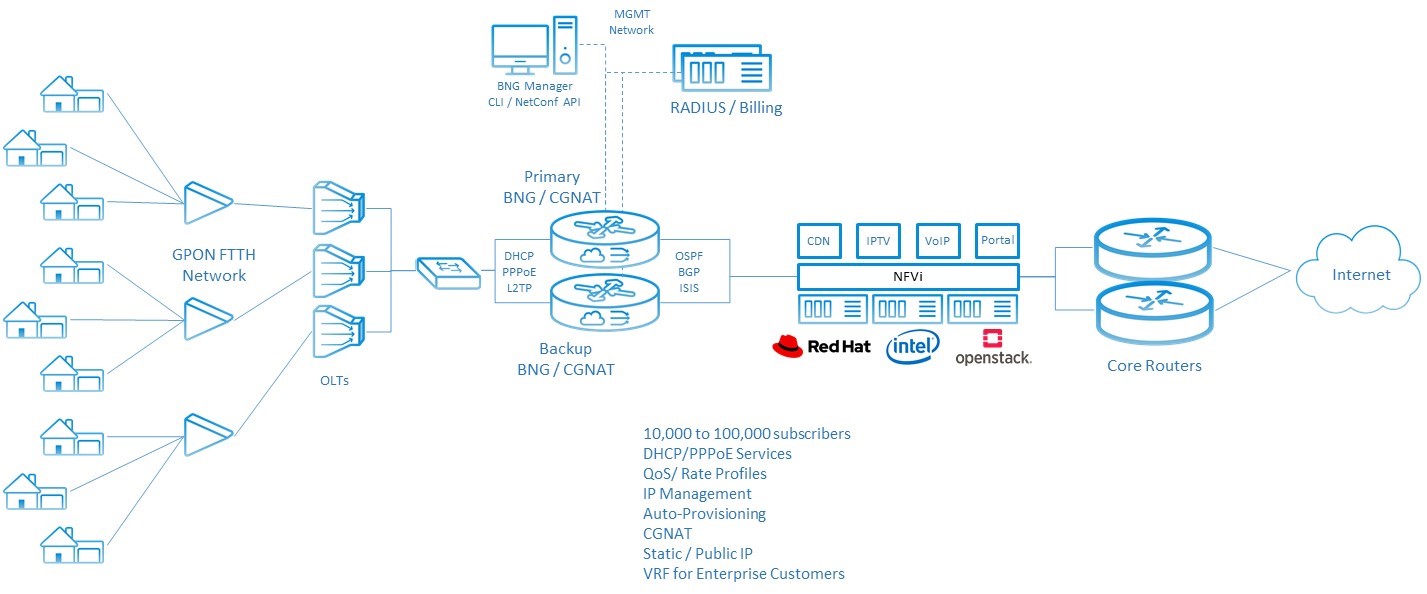Solutions for Large Carriers
Virtual BNG for Network Transformation
Next Generation Central Office Ready
Carrier networks are changing, and so are broadband network gateways. As more network functions become virtualized, carriers are looking to virtual Broadband Network Gateways (vBNGs or vBRAS) to simplify operations and eliminate inflexible and costly legacy equipment.
netElastic was one of the first companies to offer a Virtual BNG and has worked with carriers worldwide to develop innovative technologies that accelerate network transformation and improve profits.
Carrier Network Transformation
Large carriers implementing Next Generation Central Office and Telco Cloud architectures will appreciate netElastic vBNG’s flexibility. vBNG can run in a VM or on dedicated bare metal hardware. This flexibility provides a future-proof solution that allows carriers to deploy vBNG today while retaining the ability to migrate to their telco cloud when ready.
Performance and Scalability
netElastic vBNG delivers near line-rate (256-byte packets) per 10/15/40/100G interfaces. It also delivers up to 1 Terabit of throughput on a 2RU server. The same vBNG software can start as small as 2 x 10 Gbps for less demanding use cases and scale up as demand (and revenue) grows.
HIGHLIGHTS

Software Flexibility
netElastic virtual BNG is a full-featured broadband network gateway that runs on x86 servers. This approach allows broadband providers to select the scale and deployment design that best fits their network, whether it’s a large centralized platform or a set of smaller decentralized BNGs deployed close to the customer edge. And since it runs on standard off-the-shelf hardware and works with all OLT and DSLAM equipment, there is no hardware vendor lock-in.
Lower Costs Support Emerging Economies
Global carriers operating in countries with emerging economies can’t pass on the high cost of traditional proprietary infrastructure to their customers. netElastic vBNG is significantly lower in cost, even when compared to the discounted offers of most legacy vendors. Service providers in Africa, South America, and India choose netElastic vBNG because of its lower costs for licensing, ongoing support, and operations. These savings allow you to keep prices affordable and attractive for your customers.
Lower TCO also benefits service providers in developed markets, freeing capital for business expansion and improving customer experience.
The Advanced Features You Need
netElastic vBNG provides all the features required to operate the network and manage subscriber access without paying for unnecessary features. IPoE/DHCP and PPPoE services, ACL, QoS, rate profiles, and IP address management are all included. RADIUS AAA (with COA) allows integration with billing and automation, while BGP, OSPF, and ISIS routing protocols support core network requirements. MPLS features include subscriber to VRF mapping to support business broadband for enterprise clients.
Carrier Grade NAT (CGNAT) and IPv6 Transition
With no new IPv4 addresses available and IPv6 still not fully adopted, many broadband service providers are forced to buy or rent expensive IPv4 addresses.
netElastic’s software-based CGNAT is built on netElastic’s high-performance virtual router technology. This very scalable software architecture delivers high translation performance while supporting a broad range of additional routing capabilities. netElastic CGNAT also supports detailed session logging that is compatible with many government regulations.
For service providers transitioning to IPv6, CGNAT supports Dual Stack and full IPv6 support. CGNAT for IPv4 and Dual Stack IPv4/v6 allows network operators to deliver the IPv4 services needed now while being fully prepared for an all-IPv6 network.

